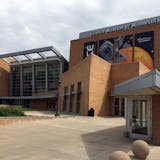Public transit enthusiasts and a host of elected officials on Saturday celebrated the opening of the new D Line, providing bus-rapid transit service between Brooklyn Center and the Mall of America through the heart of Minneapolis — the busiest bus corridor in the state.
But the good news for the commuting public was somewhat tempered by Metro Transit service cuts that also went into effect Saturday, prompted by a lack of bus drivers.
The $75 million D Line, which was completed on time and under budget, is a vast improvement over existing Route 5 local service. It features heated stations, real-time schedule information and security cameras on platforms. As with other BRT lines, it requires payment before boarding and features signal priority at intersections to hasten service, which is up to 25% faster.
Major employers along the 18-mile D Line include Hennepin Healthcare, Abbott Northwestern Hospital, Children's Minnesota and the Mall of of America in Bloomington. The corridor is important to the Metro Transit system, said Katie Roth, director of arterial bus-rapid transit service at Metro Transit.
"There are a lot of customers on this corridor who use transit to get to jobs, to school, for shopping, and to see family and friends," she said.
At the same time, service is being cut by 8% as dozens of bus routes have been curtailed or eliminated. The move follows previous cuts prompted by the COVID-19 pandemic, when many people chose to stay home and work remotely. Only about half of Metro Transit's overall ridership has returned, though ridership on bus-rapid transit routes has made a stronger recovery.
When asked whether it's wise to expand transit service when people can't be found to operate buses and trains, Metro Transit spokesman Drew Kerr said bus-rapid transit lines like the D Line are largely replacing local bus routes, making a significant boost in drivers unnecessary.
"Staffing needs are being continuously evaluated as we develop future service plans, including the introduction of new services," Kerr said in an email.



